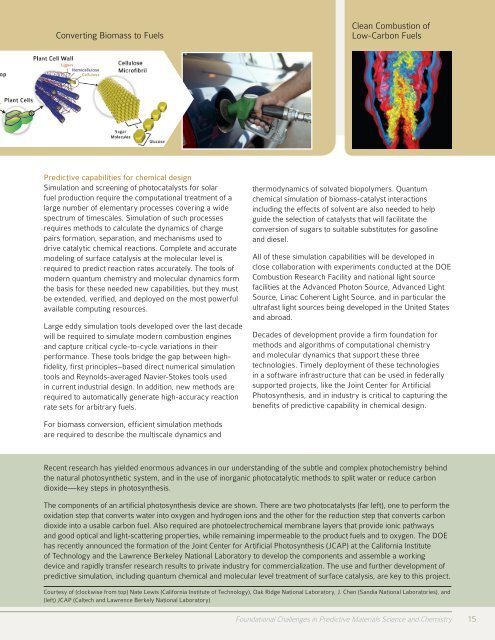Computational Materials Science and Chemistry ... - Office of Science
Computational Materials Science and Chemistry ... - Office of Science
Computational Materials Science and Chemistry ... - Office of Science
Create successful ePaper yourself
Turn your PDF publications into a flip-book with our unique Google optimized e-Paper software.
Converting Biomass to Fuels<br />
Predictive capabilities for chemical design<br />
Simulation <strong>and</strong> screening <strong>of</strong> photocatalysts for solar<br />
fuel production require the computational treatment <strong>of</strong> a<br />
large number <strong>of</strong> elementary processes covering a wide<br />
spectrum <strong>of</strong> timescales. Simulation <strong>of</strong> such processes<br />
requires methods to calculate the dynamics <strong>of</strong> charge<br />
pairs formation, separation, <strong>and</strong> mechanisms used to<br />
drive catalytic chemical reactions. Complete <strong>and</strong> accurate<br />
modeling <strong>of</strong> surface catalysis at the molecular level is<br />
required to predict reaction rates accurately. The tools <strong>of</strong><br />
modern quantum chemistry <strong>and</strong> molecular dynamics form<br />
the basis for these needed new capabilities, but they must<br />
be extended, verified, <strong>and</strong> deployed on the most powerful<br />
available computing resources.<br />
Large eddy simulation tools developed over the last decade<br />
will be required to simulate modern combustion engines<br />
<strong>and</strong> capture critical cycle-to-cycle variations in their<br />
performance. These tools bridge the gap between highfidelity,<br />
first principles–based direct numerical simulation<br />
tools <strong>and</strong> Reynolds-averaged Navier-Stokes tools used<br />
in current industrial design. In addition, new methods are<br />
required to automatically generate high-accuracy reaction<br />
rate sets for arbitrary fuels.<br />
For biomass conversion, efficient simulation methods<br />
are required to describe the multiscale dynamics <strong>and</strong><br />
Clean Combustion <strong>of</strong><br />
Low-Carbon Fuels<br />
thermodynamics <strong>of</strong> solvated biopolymers. Quantum<br />
chemical simulation <strong>of</strong> biomass-catalyst interactions<br />
including the effects <strong>of</strong> solvent are also needed to help<br />
guide the selection <strong>of</strong> catalysts that will facilitate the<br />
conversion <strong>of</strong> sugars to suitable substitutes for gasoline<br />
<strong>and</strong> diesel.<br />
All <strong>of</strong> these simulation capabilities will be developed in<br />
close collaboration with experiments conducted at the DOE<br />
Combustion Research Facility <strong>and</strong> national light source<br />
facilities at the Advanced Photon Source, Advanced Light<br />
Source, Linac Coherent Light Source, <strong>and</strong> in particular the<br />
ultrafast light sources being developed in the United States<br />
<strong>and</strong> abroad.<br />
Decades <strong>of</strong> development provide a firm foundation for<br />
methods <strong>and</strong> algorithms <strong>of</strong> computational chemistry<br />
<strong>and</strong> molecular dynamics that support these three<br />
technologies. Timely deployment <strong>of</strong> these technologies<br />
in a s<strong>of</strong>tware infrastructure that can be used in federally<br />
supported projects, like the Joint Center for Artificial<br />
Photosynthesis, <strong>and</strong> in industry is critical to capturing the<br />
benefits <strong>of</strong> predictive capability in chemical design.<br />
Recent research has yielded enormous advances in our underst<strong>and</strong>ing <strong>of</strong> the subtle <strong>and</strong> complex photochemistry behind<br />
the natural photosynthetic system, <strong>and</strong> in the use <strong>of</strong> inorganic photocatalytic methods to split water or reduce carbon<br />
dioxide—key steps in photosynthesis.<br />
The components <strong>of</strong> an artificial photosynthesis device are shown. There are two photocatalysts (far left), one to perform the<br />
oxidation step that converts water into oxygen <strong>and</strong> hydrogen ions <strong>and</strong> the other for the reduction step that converts carbon<br />
dioxide into a usable carbon fuel. Also required are photoelectrochemical membrane layers that provide ionic pathways<br />
<strong>and</strong> good optical <strong>and</strong> light-scattering properties, while remaining impermeable to the product fuels <strong>and</strong> to oxygen. The DOE<br />
has recently announced the formation <strong>of</strong> the Joint Center for Artificial Photosynthesis (JCAP) at the California Institute<br />
<strong>of</strong> Technology <strong>and</strong> the Lawrence Berkeley National Laboratory to develop the components <strong>and</strong> assemble a working<br />
device <strong>and</strong> rapidly transfer research results to private industry for commercialization. The use <strong>and</strong> further development <strong>of</strong><br />
predictive simulation, including quantum chemical <strong>and</strong> molecular level treatment <strong>of</strong> surface catalysis, are key to this project.<br />
Courtesy <strong>of</strong> (clockwise from top) Nate Lewis (California Institute <strong>of</strong> Technology), Oak Ridge National Laboratory, J. Chen (S<strong>and</strong>ia National Laboratories), <strong>and</strong><br />
(left) JCAP (Caltech <strong>and</strong> Lawrence Berkely National Laboratory)<br />
Foundational Challenges in Predictive <strong>Materials</strong> <strong>Science</strong> <strong>and</strong> <strong>Chemistry</strong><br />
15

















